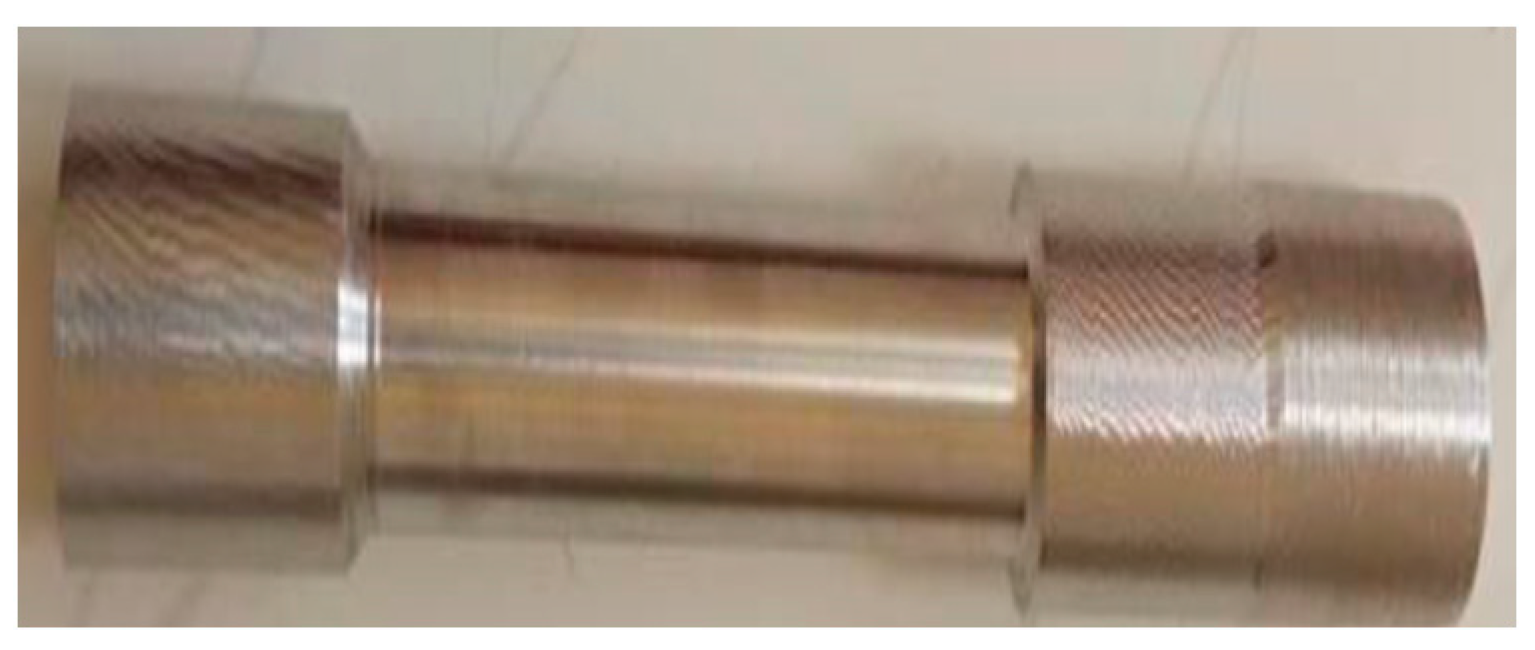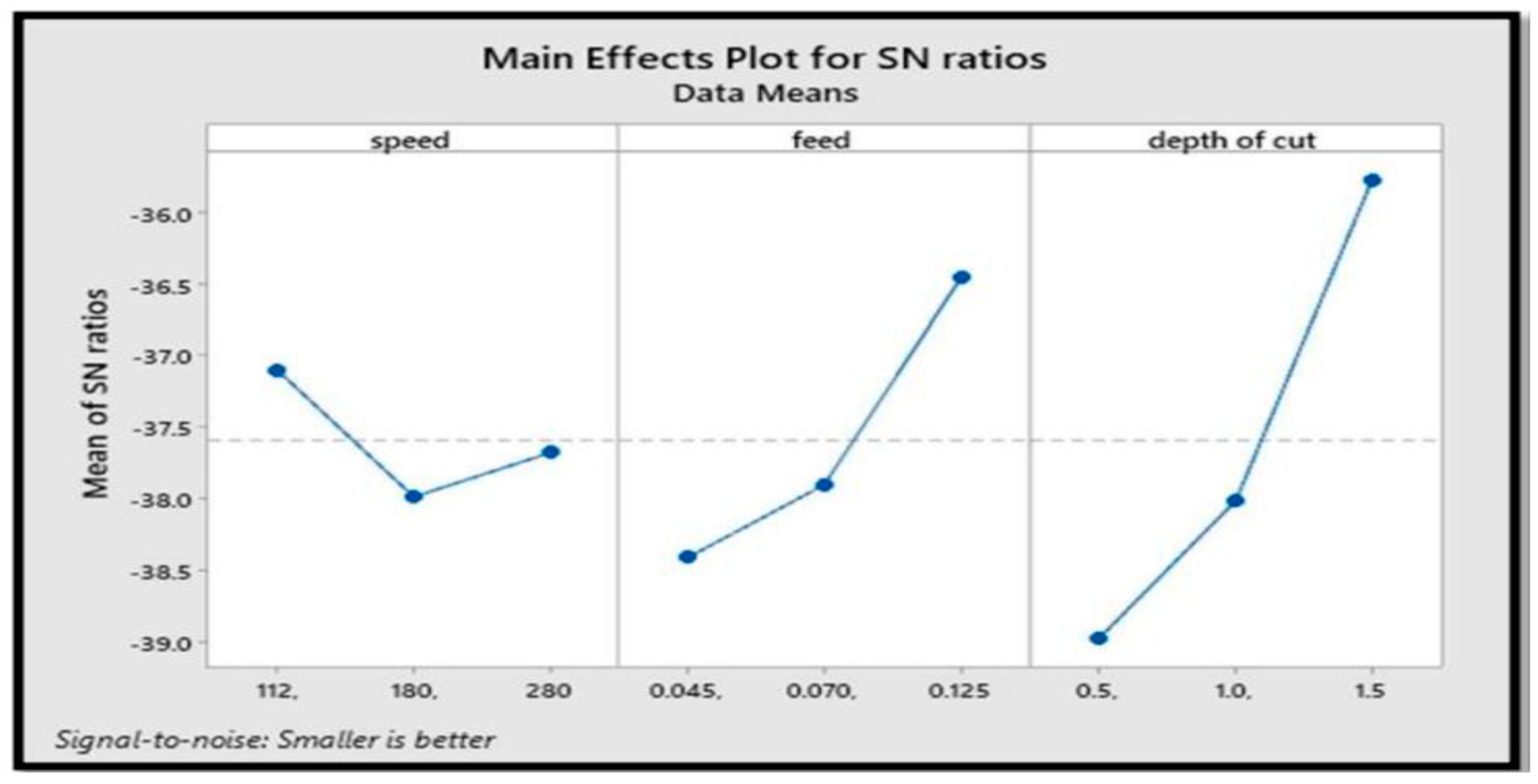Comparative Study on the Effect of Tool Wear on Turning Mild Steel and Stainless Steel with a Ceramic Tool Insert Using Taguchi Method †
Abstract
1. Introduction
2. Experimental Details
2.1. Stainless Steel 304
2.2. Mild Steel 1020
2.3. Profile Projector
2.4. Surfcom Flex
2.5. Tool Holder and Tool Insert
3. Results and Discussion
4. Conclusions
Author Contributions
Funding
Institutional Review Board Statement
Informed Consent Statement
Data Availability Statement
Conflicts of Interest
References
- Thangarasu, S.K.; Shankar, S.; Thomas, A.T.; Sridhar, G. Prediction of Cutting Force in Turning Process-an Experimental Approach. IOP Conf. Ser. Mater. Sci. Eng. 2018, 310, 012119. [Google Scholar] [CrossRef]
- Nayak, M.; Sehgal, R. Effect of Tool Material Properties and Cutting Conditions on Machinability of AISI D6 Steel During Hard Turning. Arab. J. Sci. Eng. 2015, 40, 1151–1164. [Google Scholar] [CrossRef]
- Moganapriya, C.; Rajasekar, R.; Ponappa, K.; Kumar, P.S.; Pal, S.K.; Kumar, J.S. Effect of coating on tool inserts and cutting fluid flow rate on the machining performance of AISI 1015 steel. Mater. Test. 2018, 60, 1202–1208. [Google Scholar] [CrossRef]
- Looney, L.A.; Monaghan, J.M.; O’Reilly, P.; Taplin, D.M.R. The turning of an Al/SiC metal-matrix composite. J. Mater. Process. Technol. 1992, 33, 453–468. [Google Scholar] [CrossRef]
- Makadia, A.J.; Nanavati, J.I. Optimisation of machining parameters for turning operations based on response surface methodology. Measurement 2013, 46, 1521–1529. [Google Scholar] [CrossRef]
- Debnath, S.; Reddy, M.M.; Yi, Q.S. Influence of cutting fluid conditions and cutting parameters on surface roughness and tool wear in turning process using Taguchi method. Measurement 2016, 78, 111–119. [Google Scholar] [CrossRef]
- Suresh, R.; Joshi, A.G.; Suresh, R.; Joshi, A.G. Investigations on Machinability Characteristics of Hardened AISI H13 Steel with Multilayer Coated Carbide Tool Using Statistical Techniques. Available online: https://services.igi-global.com/resolvedoi/resolve.aspx?doi=10.4018/978-1-5225-2440-3.ch009 (accessed on 7 November 2021).
- Gaitonde, V.N.; Karnik, S.R.; Figueira, L.; Davim, J.P. Analysis of Machinability During Hard Turning of Cold Work Tool Steel (Type: AISI D2). Mater. Manuf. Process. 2009, 24, 1373–1382. [Google Scholar] [CrossRef]
- O’Sullivan, D.; Cotterell, M. Temperature measurement in single point turning. J. Mater. Process. Technol. 2001, 118, 301–308. [Google Scholar] [CrossRef]
- Dogu, Y.; Aslan, E.; Camuscu, N. A numerical model to determine temperature distribution in orthogonal metal cutting. J. Mater. Process. Technol. 2006, 171, 1–9. [Google Scholar] [CrossRef]
- Bensouilah, H.; Aouici, H.; Meddour, I.; Yallese, M.A.; Mabrouki, T.; Girardin, F. Performance of coated and uncoated mixed ceramic tools in hard turning process. Measurement 2016, 82, 1–18. [Google Scholar] [CrossRef]
- Joshi, K.K.; Behera, R.K.; Anurag. Effect of minimum quantity lubrication with Al2O3 Nanofluid on Surface Roughness and its prediction using hybrid fuzzy controller in turning operation of Inconel 600. Mater. Today Proc. 2018, 5 Pt 3, 20660–20668. [Google Scholar] [CrossRef]
- Muthusamy, Y.; Kadirgama, K.; Rahman, M.M.; Ramasamy, D.; Sharma, K.V. Wear analysis when machining AISI 304 with ethylene glycol/TIO2 nanoparticle-based coolant. Int. J. Adv. Manuf. Technol. 2016, 82, 327–340. [Google Scholar] [CrossRef]








| Sl. No. | Cutting Speed in rpm | Feed in mm/rev | DOC in mm |
|---|---|---|---|
| 1 | 112 | 0.045 | 0.5 |
| 2 | 112 | 0.070 | 1.0 |
| 3 | 112 | 1.0125 | 1.5 |
| 4 | 180 | 0.045 | 1.0 |
| 5 | 180 | 0.070 | 1.5 |
| 6 | 180 | 1.0125 | 0.5 |
| 7 | 280 | 0.045 | 1.5 |
| 8 | 280 | 0.070 | 0.5 |
| 9 | 280 | 1.0125 | 1.0 |
| Sl. No. | Cutting Speed in rpm | Feed in mm/rev | DOC in mm | RA (μm) | RZ (μm) | RT (μm) | RPK (μm) | Tool Wear in (μm) |
|---|---|---|---|---|---|---|---|---|
| 1 | 112 | 0.045 | 0.5 | 1.124 | 6.355 | 11.07 | 2.30 | 79 |
| 2 | 112 | 0.070 | 1.0 | 1.340 | 8.240 | 14.91 | 2.69 | 92.9 |
| 3 | 112 | 1.0125 | 1.5 | 1.285 | 10.24 | 22.88 | 1.43 | 50 |
| 4 | 180 | 0.045 | 1.0 | 0.583 | 4.72 | 5.936 | 1.68 | 90 |
| 5 | 180 | 0.070 | 1.5 | 1.713 | 8.851 | 12.46 | 2.05 | 57 |
| 6 | 180 | 1.0125 | 0.5 | 2.541 | 13.49 | 20.81 | 5.53 | 97.3 |
| 7 | 280 | 0.045 | 1.5 | 3.695 | 18.89 | 27.31 | 4.37 | 81.3 |
| 8 | 280 | 0.070 | 0.5 | 0.779 | 5.197 | 8.032 | 2.75 | 91.5 |
| 9 | 280 | 1.0125 | 1.0 | 1.379 | 8.506 | 14.56 | 2.83 | 60.3 |
| Sl. No. | Cutting Speed in rpm | Feed in mm/rev | DOC in mm | RA (μm) | RZ (μm) | RT (μm) | RPK (μm) | Tool Wear in (μm) |
|---|---|---|---|---|---|---|---|---|
| 1 | 112 | 0.045 | 0.5 | 3.27 | 21.54 | 40.49 | 7.318 | 17 |
| 2 | 112 | 0.070 | 1.0 | 1.306 | 8.051 | 15.10 | 2.281 | 90 |
| 3 | 112 | 1.0125 | 1.5 | 4.985 | 22.28 | 42.26 | 7.63 | 26.9 |
| 4 | 180 | 0.045 | 1.0 | 2.434 | 13.09 | 22.08 | 2.204 | 97.3 |
| 5 | 180 | 0.070 | 1.5 | 3.788 | 19.74 | 24.75 | 4.346 | 13 |
| 6 | 180 | 1.0125 | 0.5 | 1.698 | 12.11 | 24.12 | 5.196 | 74 |
| 7 | 280 | 0.045 | 1.5 | 7.194 | 29.49 | 43.24 | 5.723 | 25 |
| 8 | 280 | 0.070 | 0.5 | 0.825 | 4.755 | 6.496 | 1.488 | 40 |
| 9 | 280 | 1.0125 | 1.0 | 1.714 | 10.46 | 18.88 | 3.275 | 20 |
Disclaimer/Publisher’s Note: The statements, opinions and data contained in all publications are solely those of the individual author(s) and contributor(s) and not of MDPI and/or the editor(s). MDPI and/or the editor(s) disclaim responsibility for any injury to people or property resulting from any ideas, methods, instructions or products referred to in the content. |
© 2024 by the authors. Licensee MDPI, Basel, Switzerland. This article is an open access article distributed under the terms and conditions of the Creative Commons Attribution (CC BY) license (https://creativecommons.org/licenses/by/4.0/).
Share and Cite
Raghu, S.; Harti, J.I.; Jadhav, P.R.; Selvan, M.C.P.; Vijaysekar, K.S.; Venkatesh, B. Comparative Study on the Effect of Tool Wear on Turning Mild Steel and Stainless Steel with a Ceramic Tool Insert Using Taguchi Method. Eng. Proc. 2024, 61, 48. https://doi.org/10.3390/engproc2024061048
Raghu S, Harti JI, Jadhav PR, Selvan MCP, Vijaysekar KS, Venkatesh B. Comparative Study on the Effect of Tool Wear on Turning Mild Steel and Stainless Steel with a Ceramic Tool Insert Using Taguchi Method. Engineering Proceedings. 2024; 61(1):48. https://doi.org/10.3390/engproc2024061048
Chicago/Turabian StyleRaghu, S., Jayasheel I. Harti, Pankaj R. Jadhav, M. Chithirai Pon Selvan, K. S. Vijaysekar, and Bharath Venkatesh. 2024. "Comparative Study on the Effect of Tool Wear on Turning Mild Steel and Stainless Steel with a Ceramic Tool Insert Using Taguchi Method" Engineering Proceedings 61, no. 1: 48. https://doi.org/10.3390/engproc2024061048
APA StyleRaghu, S., Harti, J. I., Jadhav, P. R., Selvan, M. C. P., Vijaysekar, K. S., & Venkatesh, B. (2024). Comparative Study on the Effect of Tool Wear on Turning Mild Steel and Stainless Steel with a Ceramic Tool Insert Using Taguchi Method. Engineering Proceedings, 61(1), 48. https://doi.org/10.3390/engproc2024061048







